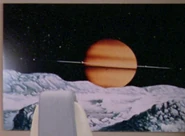m (Robot: Automated text replacement (-File:Star-chart alpha-beta quadrant.jpg +File:The Explored Galaxy.jpg)) |
mNo edit summary |
||
| (83 intermediate revisions by 26 users not shown) | |||
| Line 1: | Line 1: | ||
| + | |||
| − | {{sidebar planet |
+ | {{sidebar planet |
| ⚫ | |||
| − | | |
+ | | name = Saturn |
| − | | |
+ | | aka = Sol VI |
| − | | |
+ | | orbital = Saturn, remastered.jpg |
| − | | |
+ | | class = [[Gas giant|Gas Giant]] |
| − | | |
+ | | type = [[Planet]] |
| − | | |
+ | | satellites = [[Mimas]] and [[Titan]], plus many other moons and a [[ring system]] |
| − | | |
+ | | location = [[Sol system]]<br />[[Sector 001]]<br/>[[Alpha Quadrant]] |
| + | | affiliation = [[United Federation of Planets]] |
||
| ⚫ | |||
| + | | datestatus = 2368 |
||
}} |
}} |
||
| − | '''Saturn''' |
+ | '''Saturn''', also known as '''Sol VI''', was the [[sixth planets|sixth]] [[planet]] of the [[Sol system]]. It was well known for its [[ring system|rings]] ({{TOS|Charlie X}}; {{VOY|Future's End, Part II}}) and was orbited by many [[Moons of Saturn|moons]]; three of which were [[Mimas]], [[Rhea]], and [[Titan]]. ({{TOS|The Changeling}}; {{TNG|The First Duty}}; {{ENT|Strange New World}}; {{film|11}}) It was also orbited by [[navigational control satellite]]s. ({{TNG|The First Duty}}) Saturn's Rings were also the location of the [[Academy Flight Range|Academy Flight and Training Range]]. ({{TNG|The First Duty}}) |
| − | == Saturnian |
+ | == Saturnian rings == |
[[File:Saturn's rings.jpg|thumb|left|Saturn's rings]] |
[[File:Saturn's rings.jpg|thumb|left|Saturn's rings]] |
||
| − | + | An image of Saturn's rings, taken by the ''Voyager 2'' [[probe]] in [[1981]], was displayed in [[astrometrics]] aboard the {{USS|Voyager}} in the year [[2374]]. ({{VOY|Year of Hell}}, ''et al.'') The rings of Saturn generated magnetic distortions. These distortions could make a [[starship]] invisible to another starship if the vessel could jump out of warp behind one of the planet's moons. ({{film|11}}) |
|
| + | |||
| + | == Location == |
||
| + | [[File:Sol system map.jpg|thumb|The position and orbital path of Saturn on "Chart 14A: The Solar System"]] |
||
| + | |||
| + | In [[2024]], the position and orbital path of Saturn were depicted on a map of the Solar System, which was seen at the [[gala]] held for the [[Europa Mission]] [[astronaut]]s. ({{PIC|Two of One}}) |
||
| + | |||
| + | In [[2267]], the position and orbital path of Saturn were depicted on "Chart 14A: The Sol System", stored in the {{USS|Enterprise|NCC-1701}} library computer. The chart was scanned by the [[probe]] ''[[Nomad]]'' in [[auxiliary control]]. ({{TOS|The Changeling}} ''production art'') |
||
== History == |
== History == |
||
| − | [[File:Saturn, The Cage.jpg|thumb |
+ | [[File:Saturn, The Cage.jpg|thumb|Historical image of Saturn]] |
| + | Before the invention of the [[telescope]], [[Human]]s discovered Saturn in the night sky. ({{TNG|Loud As A Whisper}} ''okudagram'') |
||
| ⚫ | |||
| − | {{bginfo|The implications being that Humanity would eventually send manned missions to this planet. [http://history.nasa.gov/SP-4029/Apollo_18-18_Mission_Insignias.htm].}} |
||
| ⚫ | |||
| ⚫ | |||
| ⚫ | On September 1, [[1979]], the space [[probe]] ''[[Pioneer 11]]'' became the first Earth [[spacecraft]] to visit this planet, having traveled six and a half [[year]]s and 3.2 billion [[kilometer]]s. The probe discovered that this planet had a [[magnetic field]] and a [[magnetosphere]]. ({{TNG|Loud As A Whisper}} ''okudagram'') |
||
| ⚫ | When she was a child, [[Rain Robinson]] was able to see Saturn's rings through her brother's |
||
| ⚫ | When she was a child, [[Rain Robinson]] was able to see Saturn's rings through her brother's telescope. She used to think that they looked like [[jewel]]s from a [[pirate]]'s treasure. All she ever wanted since then was to reach up and touch them. This was when she realized that she wanted to become an [[astronomer]]. ({{VOY|Future's End, Part II}}) |
||
| ⚫ | |||
| ⚫ | |||
| ⚫ | During the early [[21st century]] the first manned [[Earth-Saturn probe]] was launched |
||
| + | [[File:Cassini imagery - Saturn and Moon.jpg|thumb|Image produced by Cassini]] |
||
| ⚫ | |||
| + | The [[Cassini]] mission by [[NASA]] brought more images of Saturn, its rings, and its moons. ({{DIS|Brother}}) |
||
| ⚫ | During the early [[21st century]], the first manned [[Earth-Saturn probe]] was launched under the command of NASA's [[Colonel]] [[Shaun Geoffrey Christopher]]. ({{TOS|Tomorrow is Yesterday}}) Accompanying Christopher were [[astronaut]]s [[Fontana]] and {{dis|O'Herlihy|astronaut}}. ({{ENT|First Flight}}) |
||
| ⚫ | |||
| ⚫ | |||
| − | Saturn was seen on a map depicting the Sol system scanned by ''[[Nomad]]''. ({{TOS|The Changeling}}) |
||
| ⚫ | |||
| ⚫ | |||
| + | {{bginfo|In the final draft script of "Charlie X", [[Saturn Rings|this nonsense verse]] included only one line about Saturn, although the poem was originally longer with four lines instead of two. The line about Saturn stated, "''Saturn's rings upon my finger.''" This line was evidently meshed together with the others, resulting in the depiction of Saturn in the final version of the poem.}} |
||
| ⚫ | By the early [[24th century]] a [[shuttle]] route had been established "''from [[Jupiter]] to Saturn and back, once a day, every day,''" know as "''the [[Jovian Run]].''" Both [[Edward Jellico]] and [[Geordi La Forge]] used to [[pilot]] shuttles on this route early in their [[Starfleet]] |
||
| ⚫ | |||
| ⚫ | |||
| ⚫ | By the early [[24th century]] a [[shuttle]] route had been established "''from [[Jupiter]] to Saturn and back, once a [[day]], every day,''" know as "''the [[Jovian Run]].''" Both [[Edward Jellico]] and [[Geordi La Forge]] used to [[pilot]] shuttles on this route early in their [[Starfleet]] [[career]]s. ({{TNG|Chain Of Command, Part II}}) |
||
| ⚫ | |||
| + | |||
| ⚫ | |||
| + | |||
| ⚫ | |||
[[Teero Anaydis]] kept a photograph of Saturn in his home in [[2377]]. ({{VOY|Repression}}) |
[[Teero Anaydis]] kept a photograph of Saturn in his home in [[2377]]. ({{VOY|Repression}}) |
||
| + | In [[3189]], the {{USS|Discovery}} [[Spore drive|spore-jumped]] into the vicinity of Saturn on its way to Earth. ({{DIS|People of Earth}}) |
||
| − | {{SolSystem}} |
||
<gallery> |
<gallery> |
||
| ⚫ | |||
| − | File:The Explored Galaxy.jpg|The location of Sol on "The Explored Galaxy" wall chart |
||
| − | File: |
+ | File:Saturn moon orbits.jpg|The orbits of Saturn's satellites |
</gallery> |
</gallery> |
||
| + | {{Sol system}} |
||
| ⚫ | |||
| ⚫ | |||
| ⚫ | Saturn was named after the titan (son of |
||
| + | == Appendices == |
||
| ⚫ | |||
| ⚫ | |||
| + | [[File:Saturn, TNG opening sequence.jpg|thumb|Saturn as seen in the first TNG opening sequence]] |
||
| + | According to the {{ste|4|2|254}}, Saturn has a "''[[mass]] 95 times greater than that of Earth''" and "''a diameter of some 120,800 kilometers, and orbits its sun at a mean distance of 1.4 billion kilometers''". |
||
| + | Additionally, the ''Star Trek Encyclopedia'' (4th ed., vol. 2, p. 149), ''[[Star Trek: Star Charts]]'' (p. 39, "United Federation of Planets I"), and [[StarTrek.com]] classified Saturn as a [[Class J gas giant]]. {{st.com|database_article/saturn}} This planet was a charter member of the [[United Federation of Planets]] in [[2161]]. |
||
| − | [[File:Saturn moon orbits.jpg|thumb|The orbits of Saturn's satellites]] |
||
| ⚫ | A graphic of Saturn and the orbits of four of its moons was seen in {{TNG|The First Duty}} (depicted to the right). The outermost and largest moon was identified as [[Titan]]. The remaining three inner moons weren't named but it was very likely that they were {{w|Rhea (moon)|Rhea}}, {{w|Dione (moon)|Dione}}, and {{w|Tethys (moon)|Tethys}}, as they are the largest moons with smaller orbits than Titan (for instance, {{w|Iapetus (moon)|Iapetus}} was larger than both Tethys and Dione but its orbit was further away from Saturn than Titan's) and were all discovered in the [[17th century]] and are well established. |
||
| ⚫ | Saturn was named after the titan (son of Uranus) from Roman mythology. It was unclear if Saturn itself was inhabited or not, though a reference made to [[Saturnius harem girl]]s in {{TOS|Mudd's Women}} might suggest that it somehow was. The necessity of a daily shuttle run would also seem to support this possibility. |
||
| ⚫ | |||
| ⚫ | According to ''[[Spaceflight Chronology]]'', the Earth-Saturn probe mission was conducted on the UNSS ''Lewis and Clark''. Signs of past mining activity was discovered from the second and fourth moons of Saturn, first proof of the existence of extraterrestrial intelligent life. This last detail and {{e|One Small Step}} would put the mission after 2032. |
||
| ⚫ | A graphic of Saturn and the orbits of four of its moons was seen in {{TNG|The First Duty}} (depicted to the right above). The outermost and largest moon was identified as [[Titan]]. The remaining three inner moons weren't named but it was very likely that they were {{w|Rhea (moon)|Rhea}}, {{w|Dione (moon)|Dione}}, and {{w|Tethys (moon)|Tethys}}, as they are the largest moons with smaller orbits than Titan (for instance, {{w|Iapetus (moon)|Iapetus}} was larger than both Tethys and Dione but its orbit was further away from Saturn than Titan's) and were all discovered in the [[17th century]] and are well established. |
||
| ⚫ | |||
| ⚫ | According to ''[[Spaceflight Chronology]]'' (p. 45), the Earth-Saturn probe mission was conducted on the UNSS ''Lewis and Clark''. Signs of past mining activity was discovered from the second and fourth moons of Saturn, first proof of the existence of extraterrestrial intelligent life. This last detail and {{e|One Small Step}} would put the mission after 2032. |
||
| − | === "The Explored Galaxy" === |
||
| − | This chart was first seen, chronologically, in [[2293]]. ({{film|6}}) This chart was also seen in several ''[[Star Trek: The Next Generation]]'' and ''[[Star Trek: Deep Space Nine]]'' episodes set in the [[24th century]], from the year [[2364]] to [[2370]]. These were: {{TNG|Conspiracy|The Measure Of A Man|The Emissary|The Mind's Eye|The Game}} and {{DS9|In the Hands of the Prophets|Cardassians}}. |
||
| ⚫ | |||
| − | === ''[[Star Trek: Star Charts]]'' === |
||
| − | Saturn was classified as a [[Star Trek: Star Charts#Planetary classification|J-class planet]]. This planet was a charter member of the [[United Federation of Planets]] in [[2161]]. (Pgs. 39, "United Federation of Planets I") |
||
| + | Saturn was one of the planets seen in both versions of the opening sequence of {{s|TNG}} beside the [[Earth]], [[Luna]], [[Sol]], and [[Jupiter]], shortly before the {{USS|Enterprise|NCC-1701-D|-D}} started its exploration of the unknown space. |
||
| ⚫ | |||
| ⚫ | |||
| ⚫ | |||
| + | According to the {{st-minutiae|resources/scripts/tmp.txt|shooting script}} of {{film|1}}, the ''Enterprise'' passed through the Saturnian system on its course to intercept ''[[V'ger]]''. This was changed to the Jovian system for the film. |
||
| + | |||
| ⚫ | |||
| ⚫ | |||
| ⚫ | |||
[[de:Saturn]] |
[[de:Saturn]] |
||
[[es:Saturno]] |
[[es:Saturno]] |
||
| + | [[fr:Saturne]] |
||
[[it:Saturno]] |
[[it:Saturno]] |
||
[[ja:土星]] |
[[ja:土星]] |
||
| Line 83: | Line 100: | ||
[[Category:Planets]] |
[[Category:Planets]] |
||
[[Category:Sol system]] |
[[Category:Sol system]] |
||
| + | [[Category:Deleted and unused material in background]] |
||
Latest revision as of 19:41, 11 March 2024
Saturn, also known as Sol VI, was the sixth planet of the Sol system. It was well known for its rings (TOS: "Charlie X"; VOY: "Future's End, Part II") and was orbited by many moons; three of which were Mimas, Rhea, and Titan. (TOS: "The Changeling"; TNG: "The First Duty"; ENT: "Strange New World"; Star Trek) It was also orbited by navigational control satellites. (TNG: "The First Duty") Saturn's Rings were also the location of the Academy Flight and Training Range. (TNG: "The First Duty")
Saturnian rings
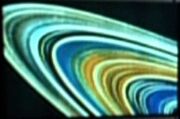
Saturn's rings
An image of Saturn's rings, taken by the Voyager 2 probe in 1981, was displayed in astrometrics aboard the USS Voyager in the year 2374. (VOY: "Year of Hell", et al.) The rings of Saturn generated magnetic distortions. These distortions could make a starship invisible to another starship if the vessel could jump out of warp behind one of the planet's moons. (Star Trek)
Location
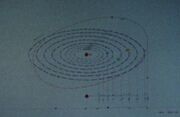
The position and orbital path of Saturn on "Chart 14A: The Solar System"
In 2024, the position and orbital path of Saturn were depicted on a map of the Solar System, which was seen at the gala held for the Europa Mission astronauts. (PIC: "Two of One")
In 2267, the position and orbital path of Saturn were depicted on "Chart 14A: The Sol System", stored in the USS Enterprise library computer. The chart was scanned by the probe Nomad in auxiliary control. (TOS: "The Changeling" production art)
History
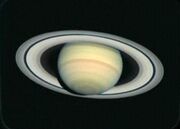
Historical image of Saturn
Before the invention of the telescope, Humans discovered Saturn in the night sky. (TNG: "Loud As A Whisper" okudagram)
In the mid-20th century, Saturn was depicted on the mission insignia for Apollo 17. On the insignia the sun god Apollo was looking toward Saturn. (ENT: "First Flight" [1])
On September 1, 1979, the space probe Pioneer 11 became the first Earth spacecraft to visit this planet, having traveled six and a half years and 3.2 billion kilometers. The probe discovered that this planet had a magnetic field and a magnetosphere. (TNG: "Loud As A Whisper" okudagram)
When she was a child, Rain Robinson was able to see Saturn's rings through her brother's telescope. She used to think that they looked like jewels from a pirate's treasure. All she ever wanted since then was to reach up and touch them. This was when she realized that she wanted to become an astronomer. (VOY: "Future's End, Part II")
In 1996, the Griffith Observatory featured an exhibit about Saturn. A picture of the planet also decorated Rain Robinson's office. (VOY: "Future's End")

Image produced by Cassini
The Cassini mission by NASA brought more images of Saturn, its rings, and its moons. (DIS: "Brother")
During the early 21st century, the first manned Earth-Saturn probe was launched under the command of NASA's Colonel Shaun Geoffrey Christopher. (TOS: "Tomorrow is Yesterday") Accompanying Christopher were astronauts Fontana and O'Herlihy. (ENT: "First Flight")
An image of Saturn was contained in the library computer aboard the USS Enterprise. This data was flashed on a viewscreen when the Talosians scanned the Enterprise computer in 2254. (TOS-R: "The Cage")
Saturn was featured in a nonsense two-line poem that Charlie Evans forced Spock to recite in 2266: "Saturn rings around my head, down a road that's Martian red." (TOS: "Charlie X")
According to Arex, the cosmic cloud encountered by the USS Enterprise in 2269 had a diameter twice that of Jupiter, Saturn, and Neptune combined. (TAS: "One of Our Planets Is Missing")
By the early 24th century a shuttle route had been established "from Jupiter to Saturn and back, once a day, every day," know as "the Jovian Run." Both Edward Jellico and Geordi La Forge used to pilot shuttles on this route early in their Starfleet careers. (TNG: "Chain Of Command, Part II")
In early 2367, the invading Borg cube passed Saturn on its way towards Earth. (TNG: "The Best of Both Worlds, Part II")
In 2368, the Nova Squadron was set to perform a demonstration near Saturn that was be transmitted to that year's Starfleet Academy graduation ceremonies. (TNG: "The First Duty")
Teero Anaydis kept a photograph of Saturn in his home in 2377. (VOY: "Repression")
In 3189, the USS Discovery spore-jumped into the vicinity of Saturn on its way to Earth. (DIS: "People of Earth")
| The Sol System |
|---|
| Sol |
| Mercury • Venus • Earth (Luna) • Mars (Deimos) • Asteroid belt • Jupiter (Io; Ganymede; Europa) • Saturn (Mimas; Rhea; Titan) • Uranus • Neptune (Triton) • Pluto |
Appendices
Background information
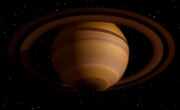
Saturn as seen in the first TNG opening sequence
According to the Star Trek Encyclopedia (4th ed., vol. 2, p. 254), Saturn has a "mass 95 times greater than that of Earth" and "a diameter of some 120,800 kilometers, and orbits its sun at a mean distance of 1.4 billion kilometers".
Additionally, the Star Trek Encyclopedia (4th ed., vol. 2, p. 149), Star Trek: Star Charts (p. 39, "United Federation of Planets I"), and StarTrek.com classified Saturn as a Class J gas giant. [2] This planet was a charter member of the United Federation of Planets in 2161.
Saturn was named after the titan (son of Uranus) from Roman mythology. It was unclear if Saturn itself was inhabited or not, though a reference made to Saturnius harem girls in TOS: "Mudd's Women" might suggest that it somehow was. The necessity of a daily shuttle run would also seem to support this possibility.
The Janus loop training program may be named after or related to Janus, another moon of Saturn.
A graphic of Saturn and the orbits of four of its moons was seen in TNG: "The First Duty" (depicted to the right above). The outermost and largest moon was identified as Titan. The remaining three inner moons weren't named but it was very likely that they were Rhea, Dione, and Tethys, as they are the largest moons with smaller orbits than Titan (for instance, Iapetus was larger than both Tethys and Dione but its orbit was further away from Saturn than Titan's) and were all discovered in the 17th century and are well established.
According to Spaceflight Chronology (p. 45), the Earth-Saturn probe mission was conducted on the UNSS Lewis and Clark. Signs of past mining activity was discovered from the second and fourth moons of Saturn, first proof of the existence of extraterrestrial intelligent life. This last detail and "One Small Step" would put the mission after 2032.
A painting seen in TNG: "Justice", according to Rick Sternbach, was meant to show Saturn as seen from its moon Rhea.
Saturn was one of the planets seen in both versions of the opening sequence of Star Trek: The Next Generation beside the Earth, Luna, Sol, and Jupiter, shortly before the USS Enterprise-D started its exploration of the unknown space.
According to the shooting script of Star Trek: The Motion Picture, the Enterprise passed through the Saturnian system on its course to intercept V'ger. This was changed to the Jovian system for the film.
External links
- Saturn at Memory Beta, the wiki for licensed Star Trek works
- Saturn at Wikipedia

